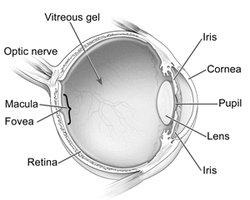|
February is National AMD & Low Vision Awareness Month. AMD, or Age-Related Macular Degeneration, is the leading cause of vision loss for Americans age 50 and older and is a common cause of a condition called low vision.
AMD can occur gradually over time as we age, making vision changes and gradual loss of vision more difficult to detect, or it can occur rapidly, leading to vision loss in both eyes. While people with AMD will retain peripheral (side) vision, AMD can make focusing and detecting colors more difficult.
Because AMD can lead to low vision and even loss of vision in severe cases, understanding who is at risk and what the symptoms of AMD are is important.
Risk Factors for AMD
There are three groups of risk factors for AMD:
1. The first group of risk factors for AMD - those that we are given - includes:
2. The second group of risk factors associated with our health and medical condition includes:
3. Finally, the third group of risk factors for AMD – behavior and lifestyle choices – includes:
While overall risk of AMD varies from one person to the next, it is important to understand the risk factors and, particularly for those at higher risk, to minimize your controllable risk factors. For example, if you know you are at a higher risk for AMD, minimizing sun exposure by wearing blue-light filtering sunglasses or eating a well-balanced diet high in antioxidants may help balance or decrease your risk of developing AMD.
Symptoms of AMD
While the symptoms of AMD may progress slowly, affecting one eye first and then both, or rapidly, affecting both eyes at the same time, there are common vision changes experienced by people with AMD. They are as follows.
If you or a loved one is experiencing any of these symptoms and changes in vision, it is important to see an eye doctor as soon as possible.
To learn more about AMD and AMD prevention and symptoms, please watch the following short video clips.
In our next post in our National AMD & Low Vision Awareness Month series, learn about eye examinations and tests for AMD and how AMD is diagnosed.
If you are concerned about your vision and eye health or that of a loved one, please contact us today to schedule an appointment.
Comments are closed.
|
EYE HEALTH BLOGCategories
All
Archives
July 2024
|
|
Kadrmas Eye Care New England
55 Commerce Way, Plymouth, MA 02360
14 Tobey Road, Wareham, MA 02571 133 Falmouth Road (Rt 28), Mashpee, MA 02649 |
Phone Number:
1-508-746-8600 Hours: Monday through Friday — 8 AM – 4:30 PM |


 RSS Feed
RSS Feed
